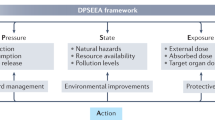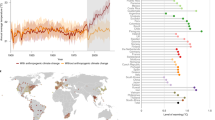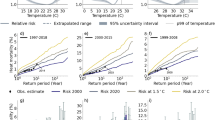Abstract
The World Health Organisation estimates that the warming and precipitation trends due to anthropogenic climate change of the past 30 years already claim over 150,000 lives annually. Many prevalent human diseases are linked to climate fluctuations, from cardiovascular mortality and respiratory illnesses due to heatwaves, to altered transmission of infectious diseases and malnutrition from crop failures. Uncertainty remains in attributing the expansion or resurgence of diseases to climate change, owing to lack of long-term, high-quality data sets as well as the large influence of socio-economic factors and changes in immunity and drug resistance. Here we review the growing evidence that climate–health relationships pose increasing health risks under future projections of climate change and that the warming trend over recent decades has already contributed to increased morbidity and mortality in many regions of the world. Potentially vulnerable regions include the temperate latitudes, which are projected to warm disproportionately, the regions around the Pacific and Indian oceans that are currently subjected to large rainfall variability due to the El Niño/Southern Oscillation sub-Saharan Africa and sprawling cities where the urban heat island effect could intensify extreme climatic events.
This is a preview of subscription content, access via your institution
Access options
Subscribe to this journal
Receive 51 print issues and online access
$199.00 per year
only $3.90 per issue
Buy this article
- Purchase on Springer Link
- Instant access to full article PDF
Prices may be subject to local taxes which are calculated during checkout



Similar content being viewed by others
References
Intergovernmental Panel on Climate Change. Climate Change 2001: The Scientific Basis: Contribution of Working Group I to the Third Assessment Report 1–944 (Cambridge Univ. Press, Cambridge, UK, 2001)
Intergovernmental Panel on Climate Change. Climate Change 2001: Impacts, Adaptation, and Vulnerability. Contribution of Working Group II to the Third Assessment Report 1–1000 (Cambridge Univ. Press, Cambridge, UK, 2001)
Stott, P. A., Stone, D. A. & Allen, M. R. Human contribution to the European heatwave of 2003. Nature 432, 610–614 (2004)
Kovats, R. S., Campbell-Lendrum, D. H., McMichael, A. J., Woodward, A. & Cox, J. S. Early effects of climate change: Do they include changes in vector-borne disease? Phil. Trans. R. Soc. Ser. B 356, 1057–1068 (2001)
Patz, J. A., Epstein, P. R., Burke, T. A. & Balbus, J. M. Global climate change and emerging infectious diseases. J. Am. Med. Assoc. 275, 217–223 (1996)
Beniston, M. The 2003 heatwave in Europe: A shape of things to come? An analysis based on Swiss climatological data and model simulations. Geophys. Res. Lett. 31, 2022–2026 (2004)
Luterbacher, J., Dietrich, D., Xoplaki, E., Grosjean, M. & Wanner, H. European seasonal and annual temperature variability, trends, and extremes since 1500. Science 303, 1499–1503 (2004)
Schar, C. et al. The role of increasing temperature variability in European summer heatwaves. Nature 427, 332–336 (2004)
International Federation of Red Cross and Red Crescent Societies. World Disaster Report 2004 Ch. 2 (IFRC, 2004)
Kosatsky, T. The 2003 European heat waves. Euro Surveill. Published online July 2005, 10(7), http://www.eurosurveillance.org/em/v10n07/1007-222.asp.
Frumkin, H. Urban sprawl and public health. Public Health Rep. 117, 201–217 (2002)
Aniello, C., Morgan, K., Busbey, A. & Newland, L. Mapping micro-urban heat islands using Landsat Tm and a GIS. Comput. Geosci. 21, 965–969 (1995)
Kalnay, E. & Cai, M. Impact of urbanization and land-use change on climate. Nature 423, 528–531 (2003)
Zhou, L. M. et al. Evidence for a significant urbanization effect on climate in China. Proc. Natl Acad. Sci. USA 101, 9540–9544 (2004)
Curriero, F. C., Heiner, K., Zeger, S., Samet, J. M. & Patz, J. A. Temperature and mortality in 11 cities of the eastern United States. Am. J. Epidemiol. 155, 80–87 (2002)
McMichael, A. J., Haines, A., Slooff, R. & Kovats, S. (eds) Climate Change and Human Health (The World Health Organization, Geneva, 1996)
Hajat, S., Kovats, R. S., Atkinson, R. W. & Haines, A. Impact of hot temperatures on death in London: a time series approach. J. Epidemiol. Commun. Health 56, 367–372 (2002)
Martens, W. J. Health impacts of climate change and ozone depletion: an ecoepidemiologic modeling approach. Environ. Health Perspect. 106 (Suppl 1), 241–251 (1998)
Gouveia, N., Hajat, S. & Armstrong, B. Socioeconomic differentials in the temperature-mortality relationship in São Paulo, Brazil. Int. J. Epidemiol. 32, 390–397 (2003)
The World Health Organisation. The World Health Report 2002 (WHO, Geneva, 2002)
Parry, M. L., Rosenzweig, C., Iglesias, A., Livermore, M. & Fischer, G. Effects of climate change on global food production under SRES emissions and socio-economic scenarios. Glob. Environ. Change 14, 53–67 (2004)
Gubler, D. J. et al. Climate variability and change in the United States: Potential impacts on vector- and rodent-borne diseases. Environ. Health Perspect. 109, 223–233 (2001)
Kuhn, K. G., Campbell-Lendrum, D. H., Armstrong, B. & Davies, C. R. Malaria in Britain: past, present, and future. Proc. Natl Acad. Sci. USA 100, 9997–10001 (2003)
Hales, S., de Wet, N., Maindonald, J. & Woodward, A. Potential effect of population and climate changes on global distribution of dengue fever: an empirical model. Lancet 360, 830–834 (2002)
Rogers, D. J. & Randolph, S. E. The global spread of malaria in a future, warmer world. Science 289, 1763–1766 (2000)
Githeko, A. K. & Ndegwa, W. Predicting malaria epidemics in the Kenyan Highlands using climate data: a tool for decision makers. Glob. Change Hum. Health 2, 54–63 (2001)
Hay, S. I. et al. Climate change and the resurgence of malaria in the East African highlands. Nature 415, 905–909 (2002)
Mouchet, J. Malaria epidemics on the Highlands of Madagascar and of East and South Africa. Bull. Soc. Pathol. Exot. 91, 64–66 (1998)
Mouchet, J. et al. Evolution of malaria in Africa for the past 40 years: impact of climatic and human factors. J. Am. Mosq. Control Assoc. 14, 121–130 (1998)
Shanks, G. D., Hay, S. I., Stern, D. I., Biomndo, K. & Snow, R. W. Meteorologic influences on Plasmodium falciparum malaria in the highland tea estates of Kericho, western Kenya. Emerg. Infect. Dis. 8, 1404–1408 (2002)
Tulu, A. N. Determinants of Malaria Transmission in the Highlands of Ethiopia. The Impact of Global Warming on Morbidity and Mortality Ascribed to Malaria. PhD thesis, Univ. London (1996)
Hopp, M. J. & Foley, J. A. Worldwide fluctuations in dengue fever cases related to climate variability. Clim. Res. 25, 85–94 (2003)
Tong, S. L., Hu, W. B. & McMichael, A. J. Climate variability and Ross River virus transmission in Townsville region, Australia, 1985–1996. Trop. Med. Int. Health 9, 298–304 (2004)
Woodruff, R., Guest, C., Garner, G., Becker, N. & Lindsay, M. F. Weather and climate as early warning system indicators for epidemics of Ross River virus: a case study in south-west western Australia. Epidemiology 14, S94–S94 (2003)
Parmenter, R. R., Yadav, E. P., Parmenter, C. A., Ettestad, P. & Gage, K. L. Incidence of plague associated with increased winter-spring precipitation in New Mexico. Am. J. Trop. Med. Hyg. 61, 814–821 (1999)
Purse, B. V. et al. Climate change and the recent emergence of bluetongue in Europe. Nature Rev. Microbiol. 3, 171–181 (2005)
Kovats, R. S. et al. The effect of temperature on food poisoning: a time-series analysis of salmonellosis in ten European countries. Epidemiol. Infect. 132, 443–453 (2004)
Bentham, G. & Langford, I. H. Environmental temperatures and the incidence of food poisoning in England and Wales. Int. J. Biometeorol. 45, 22–26 (2001)
Ropelewski, C. F. & Halpert, M. S. Global and regional scale precipitation patterns associated with the El Niño/Southern Oscillation. Mon. Weath. Rev. 111, 517–528 (1987)
Bouma, M. J. & van der Kaay, H. J. The El Niño Southern Oscillation and the historic malaria epidemics on the Indian subcontinent and Sri Lanka: an early warning system for future epidemics? Trop. Med. Int. Health 1, 86–96 (1996)
Poveda, G. et al. Coupling between annual and ENSO timescales in the malaria-climate association in Colombia. Environ. Health Perspect. 109, 489–493 (2001)
Bouma, M. J. & Dye, C. Cycles of malaria associated with El Niño in Venezuela. J. Am. Med. Assoc. 278, 1772–1774 (1997)
Lindblade, K. A., Walker, E. D., Onapa, A. W., Katungu, J. & Wilson, M. L. Highland malaria in Uganda: prospective analysis of an epidemic associated with El Niño. Trans. R. Soc. Trop. Med. Hyg. 93, 480–487 (1999)
Linthicum, K. J. et al. Climate and satellite indicators to forecast Rift Valley fever epidemics in Kenya. Science 285, 397–400 (1999)
Anyamba, A., Linthicum, K. J. & Tucker, C. J. Climate-disease connections: Rift Valley Fever in Kenya. Cad Saude Publica 17 (Suppl.), 133–140 (2001)
Cummings, D. A. et al. Travelling waves in the occurrence of dengue haemorrhagic fever in Thailand. Nature 427, 344–347 (2004)
Cazelles, B., Chavez, M., McMichael, A. J. & Hales, S. Nonstationary influence of El Niño on the synchronous dengue epidemics in Thailand. PLoS Med. 2, e106 (2005)
Glass, G. E. et al. Using remotely sensed data to identify areas at risk for hantavirus pulmonary syndrome. Emerg. Infect. Dis. 6, 238–247 (2000)
Glass, G. E. et al. Satellite imagery characterizes local animal reservoir populations of Sin Nombre virus in the southwestern United States. Proc. Natl Acad. Sci. USA 99, 16817–16822 (2002)
Checkley, W. et al. Effect of El Niño and ambient temperature on hospital admissions for diarrhoeal diseases in Peruvian children. Lancet 355, 442–450 (2000)
Pascual, M., Rodo, X., Ellner, S. P., Colwell, R. & Bouma, M. J. Cholera dynamics and El Niño-Southern Oscillation. Science 289, 1766–1769 (2000)
Rodo, X., Pascual, M., Fuchs, G. & Faruque, A. S. ENSO and cholera: a non-stationary link related to climate change? Proc. Natl Acad. Sci. 99, 12901–12906 (2002)
Colwell, R. R. Global climate and infectious disease: the cholera paradigm. Science 274, 2025–2031 (1996)
Koelle, K., Rodo, X., Pascual, M., Yunus, M. & Mostafa, G. Refractory periods and climate forcing in cholera dynamics. Nature 436, 696–700 (2005)
Lindblade, K. A., Walker, E. D., Onapa, A. W., Katungu, J. & Wilson, M. L. Land use change alters malaria transmission parameters by modifying temperature in a highland area of Uganda. Trop. Med. Int. Health 5, 263–274 (2000)
McMichael, A. J. Impact of climatic and other environmental changes on food production and population health in the coming decades. Proc. Nutr. Soc. 60, 195–201 (2001)
McMichael, A. J. et al. in Comparative Quantification of Health Risks: Global and Regional Burden of Disease due to Selected Major Risk Factors (eds Ezzati, M., Lopez, A. D., Rodgers, A. & Murray, C. J. L.) Ch. 20, 1543–1649 (World Health Organization, Geneva, 2004)
Arnell, N. W. The consequences of CO2 stabilization for the impacts of climate change. Clim. Change 53, 413–446 (2002)
Meehl, G. A. & Tebaldi, C. More intense, more frequent, and longer lasting heatwaves in the 21st century. Science 305, 994–997 (2004)
Tanser, F. C., Sharp, B. & le Sueur, D. Potential effect of climate change on malaria transmission in Africa. Lancet 362, 1792–1798 (2003)
Hay, S. I. et al. Climate variability and malaria epidemics in the highlands of East Africa. Trends Parasitol. 21, 53–63 (2005)
Reiter, P. et al. Global warming and malaria: a call for accuracy. Lancet Infect. Dis. 4, 323–324 (2004)
Meehl, G. A., Covey, C., McAvaney, B., Latif, M. & Stouffer, R. J. Overview of the Coupled Model Intercomparison Project. Bull. Am. Meteorol. Soc. 86, 89–93 (2005)
Knowlton, K. et al. Assessing ozone-related health impacts under a changing climate. Environ. Health Perspect. 112, 1557–1563 (2004)
McMichael, A. et al. Human Health and Climate Change in Oceania: A Risk Assessment (Commonwealth of Australia, Canberra, 2003)
Hogrefe, C. et al. Simulating changes in regional air pollution over the eastern United States due to changes in global and regional climate and emissions. J. Geophys. Res. 109, 2627–2638 (2004)
Patz, J. A. et al. Heat Advisory: Climate Change, Air Pollution, and Health in the US (Natural Resources Defense Council, Washington, 2004)
Hayhoe, K. et al. Emissions pathways, climate change, and impacts on California. Proc. Natl Acad. Sci. USA 101, 12422–12427 (2004)
Thomson, M. C., Mason, S. J., Phindela, T. & Connor, S. J. Use of rainfall and sea surface temperature monitoring for malaria early warning in Botswana. Am. J. Trop. Med. Hyg. 73, 214–221 (2005)
Sheridan, S. C. & Kalkstein, L. S. Health watch/warning systems in urban areas. World Res. Rev. 10, 375–383 (1998)
Weisskopf, M. G. et al. Heatwave morbidity and mortality, Milwaukee, Wis, 1999 vs 1995: an improved response? Am. J. Public Health 92, 830–833 (2002)
Sheridan, S. C. & Kalkstein, L. S. Progress in heat watch-warning system technology. Bull. Am. Meteorol. Soc. 85, 1931–1941 (2004)
Michelozzi, P. et al. Impact of heatwaves on mortality—Rome, Italy, June-August 2003. J. Am. Med. Assoc. 291, 2537–2538 (2004); reprinted from Morb. Mort. Weekly Rep. 53, 369–371 (2004)
Tan, J. G. et al. An operational heat/health warning system in Shanghai. Int. J. Biometeorol. 48, 157–162 (2004)
Ebi, K. L., Teisberg, T. J., Kalkstein, L. S., Robinson, L. & Weiher, R. F. Heat watch/warning systems save lives—Estimated costs and benefits for Philadelphia 1995–98. Bull. Am. Meteorol. Soc. 85, 1067–1073 (2004)
Acknowledgements
We thank contributors to the climate change portion of the WHO Global Burden of Disease Assessment led by T. McMichael for the data and analysis incorporated into Table 1 and Fig. 2. For constructing figures and tables and assisting in manuscript preparation, we thank S. Olson, E. Sowatzke, M. Sternitzky and D. Zaks. We thank C. Tebaldi for providing technical information on the 2003 European heatwave, and C. Hogrefe for providing Fig. 3. We also thank M. Pascual and J. Ahumada for assistance with manuscript revisions. The views expressed in this article are those of the authors and do not necessarily reflect the position of the World Health Organization.
Author information
Authors and Affiliations
Corresponding author
Ethics declarations
Competing interests
Reprints and permissions information is available at npg.nature.com/reprintsandpermissions. The authors declare no competing financial interests.
Rights and permissions
About this article
Cite this article
Patz, J., Campbell-Lendrum, D., Holloway, T. et al. Impact of regional climate change on human health. Nature 438, 310–317 (2005). https://doi.org/10.1038/nature04188
Issue Date:
DOI: https://doi.org/10.1038/nature04188
This article is cited by
-
Severe weather disasters to epidemics in China during low and high solar activities from 1 to 1911 Common Era
Geoscience Letters (2024)
-
Street trees provide an opportunity to mitigate urban heat and reduce risk of high heat exposure
Scientific Reports (2024)
-
Spatiotemporal link between El Niño Southern Oscillation (ENSO), extreme heat, and thermal stress in the Asia–Pacific region
Scientific Reports (2024)
-
Systematic review of the uncertainty of coral reef futures under climate change
Nature Communications (2024)
-
The effects of cool roofs on health, environmental, and economic outcomes in rural Africa: study protocol for a community-based cluster randomized controlled trial
Trials (2024)
Comments
By submitting a comment you agree to abide by our Terms and Community Guidelines. If you find something abusive or that does not comply with our terms or guidelines please flag it as inappropriate.



